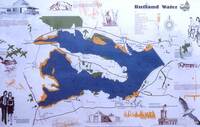New urban reservoirs could be planned in conjunction with new towns or town extension schemes, thus helping to save wild lakes from over-exploitation. Despite the imposition of rigorous controls, most urban areas continue to expand into open country, creating the hated 'urban sprawl'. Better suburbs can be designed on better sites. One way of making a dull site into an exciting site is by constructing a major water feature: few great gardens or public parks are without a central water feature. Even large commercial developments, like the National Exhibition Centre in Birmingham, are often furnished with large lakes. It is quite possible that a site could be found for a combined new town and reservoir development project. This might have been done between 1965ï¾85 in the East Midlands. A town expansion scheme took place in Peterborough and, 25 km away, Rutland Water was built. The five villages which surround Rutland Water have become more prosperous since its completion and are now sought-after residential areas. Houses and gardens overlooking the reservoir are being developed with picture windows, home extensions and viewing areas. The demand is manifest.
In California 'land that sells for a few hundred dollars per acre is worth thousands of dollars per acre if it is near a lake and up to $100,000 per acre if it is a lakeï¾front parcel' (Stefan 1981: 89). Britain does not have a tradition of building lakeside towns but they are not so different from seaside towns and new traditions can be launched - as happened with seaside resorts in the eighteenth century. A small start has been made at Brent Reservoir in North London: it is a canal feeder reservoir and not subject to the same restrictions as supply reservoirs. Some new housing has also been built near water supply reservoirs, like Grafham Water, when older dwellings have been inundated.
In mountain areas there is a considerable demand for second homes, and sites could be found beside reservoirs. A holiday village could, for example, be sited beside Kielder reservoir, either near Bakethin Dam or on a peninsular projecting into the water. If well designed it would contribute to the scenery like Mont St Michelle in France and Sveti Stefan in Yugoslavia.

